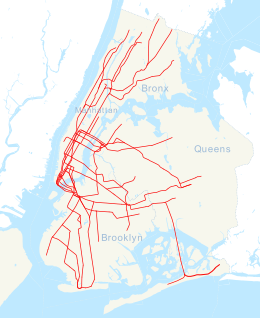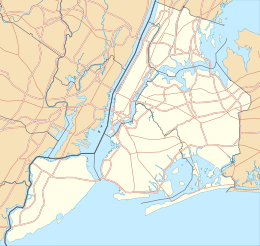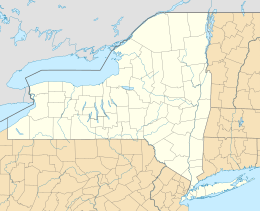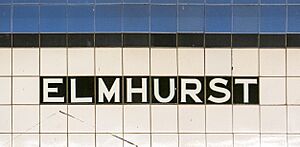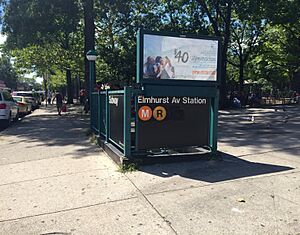Elmhurst Avenue station facts for kids
Quick facts for kids
Elmhurst Avenue
|
|||||||||||
|---|---|---|---|---|---|---|---|---|---|---|---|
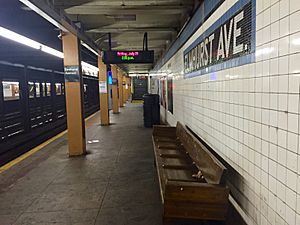
Manhattan bound platform with mosaic.
|
|||||||||||
| Station statistics | |||||||||||
| Address | Elmhurst Avenue, 45th Avenue, & Broadway Elmhurst, NY 11373 |
||||||||||
| Borough | Queens | ||||||||||
| Locale | Elmhurst | ||||||||||
| Coordinates | 40°44′30″N 73°52′52″W / 40.741795°N 73.88104°W | ||||||||||
| Division | B (IND) | ||||||||||
| Line | IND Queens Boulevard Line | ||||||||||
| Services | E nightsonly (late nights) M weekdaysonly (weekdays until 11 p.m.) R allexceptnights (all hours except late nights) |
||||||||||
| Transit connections | |||||||||||
| Structure | Underground | ||||||||||
| Platforms | 2 side platforms | ||||||||||
| Tracks | 4 | ||||||||||
| Other information | |||||||||||
| Opened | December 31, 1936 | ||||||||||
| Station code | 266 | ||||||||||
| Wireless service | |||||||||||
| Opposite-direction transfer available | Yes | ||||||||||
| Traffic | |||||||||||
| Passengers (2019) | 3,867,341 |
||||||||||
| Rank | 127 out of 425 | ||||||||||
| Station succession | |||||||||||
| Next east | Grand Avenue–Newtown: E nightsonly M weekdaysonly R allexceptnights | ||||||||||
| Next west | Jackson Heights–Roosevelt Avenue: E nightsonly M weekdaysonly R allexceptnights | ||||||||||
|
|||||||||||
|
|||||||||||
|
|||||||||||
|
|
|||||||||||
|
Elmhurst Avenue Subway Station (IND)
|
|||||||||||
| MPS | New York City Subway System MPS | ||||||||||
| NRHP reference No. | 05000672 | ||||||||||
| Added to NRHP | July 6, 2005 | ||||||||||
The Elmhurst Avenue subway station is a local stop on the IND Queens Boulevard Line in New York City. It is found where Elmhurst Avenue, 45th Avenue, and Broadway meet in Elmhurst, Queens. This station is served by the M train on weekdays. The R train stops here at all times except late nights. The E train also serves the station during night hours.
Contents
About Elmhurst Avenue Station
Building the Subway Line
The Queens Boulevard Line was one of the first subway lines built by the city. It was part of the Independent Subway System (IND). The plan was for the line to connect Manhattan to Jamaica, Queens. A stop at Elmhurst Avenue was always part of this big plan.
The idea for the line came about in 1925. The city officially approved its construction in 1928. Workers built the subway using a method called "cut-and-cover." This means they dug a big trench, built the subway structure, and then covered it up. Temporary bridges helped people cross the trenches during construction.
The first part of the line opened in August 1933. It ran from 50th Street in Manhattan to Roosevelt Avenue in Jackson Heights. More money was approved to finish the rest of the line. The Public Works Administration helped build the remaining sections. Construction faced delays due to strikes in 1934 and 1935. The Elmhurst Avenue station was designed by engineers Robert Ridgway and Aaron I. Raisman.
By August 1936, the tracks were finished all the way to 178th Street. The stations up to Union Turnpike were also ready. On December 31, 1936, the Queens Boulevard Line officially opened eight new stops. This extended the line by about 3.5 miles (5.6 km).
How the Station Changed Elmhurst
The opening of the Elmhurst Avenue station was a big deal. It helped the Elmhurst area grow a lot. More businesses and homes were built nearby. This station was recognized as important history. It was added to the National Register of Historic Places in 2005.
Inside the Station
This subway station is underground. It has four tracks and two side platforms. The two tracks in the middle are for express trains. The E train uses these during the day. The F train also uses them all the time. The two outer tracks are for local trains like the M and R.
Platforms and Tracks
The walls along both platforms have a special design. There is a teal colored line at the top. Below it, you can see "ELMHURST" written in white letters on black tiles. There are also larger signs that say "ELMHURST AVE." in white letters. These signs have a teal border. The colors of the tiles were part of a special system. This system helped people know which subway line they were on.
The platform ceiling is held up by yellow support beams. These beams are about every 15 feet (4.6 m). They support the floor of the level above, called the mezzanine.
Station Design and Art
The subway tunnel itself has a "U" shape. This shape holds pipes and wires for the station. The outer walls of the tunnel have columns about every 5 feet (1.5 m). Concrete fills the space between them. There is a small gap between the tunnel wall and the platform wall. The platform wall is made of brick and covered with tiles.
Getting Around Inside
Above the platforms and tracks is a large area called the mezzanine. This area runs the full length of the station. It is also supported by yellow beams. The mezzanine is split into three parts by fences. The outer parts are where you pay your fare. The middle part is outside the fare area.
There is a special walkway under one of the staircases. This walkway connects the two sides of the mezzanine. This means you can switch directions without paying again. The ticket booth is in the middle of the mezzanine. There are also turnstiles to enter or exit the paid areas. Each platform has seven staircases leading up to the mezzanine.
Finding Your Way Out
The station has five entrances to the street. Two are on the northwest side of the mezzanine. Three are on the southeast side.
On the northwest side, one staircase leads to the corner of 82nd Street and Broadway. Another goes to the corner of Britton Avenue and Broadway. At this end, there are special turnstiles that only let you exit. There are also "High Entry-Exit Turnstiles" that let you enter or exit.
On the southeast side, two staircases go to the corners of 45th Avenue and Broadway. Another staircase leads to the corner of Elmhurst Avenue and Broadway. This entrance is inside a storefront. It goes through a small underground shopping area. This side also has exit-only turnstiles and High Entry-Exit Turnstiles.
Nearby Connections
The Elmhurst station on the Long Island Rail Road (LIRR) used to be very close. It was about one block south of this subway station. However, that LIRR station closed in 1985.
Between this station and the Jackson Heights–Roosevelt Avenue station, there are some interesting holes in the tunnel ceiling. These holes were meant for tunnels that were never used. They would have connected to an unused upper level at the Roosevelt Avenue station.
Images for kids
See also
 In Spanish: Avenida Elmhurst (línea Queens Boulevard) para niños
In Spanish: Avenida Elmhurst (línea Queens Boulevard) para niños


